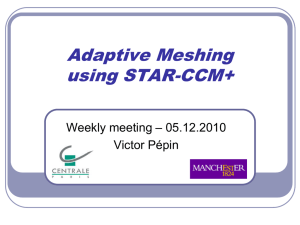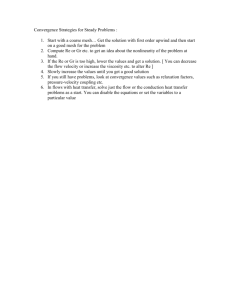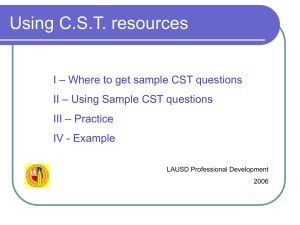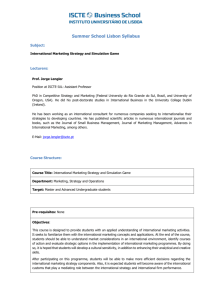A Comparison of Ansoft HFSS and CST Microwave Studio
advertisement
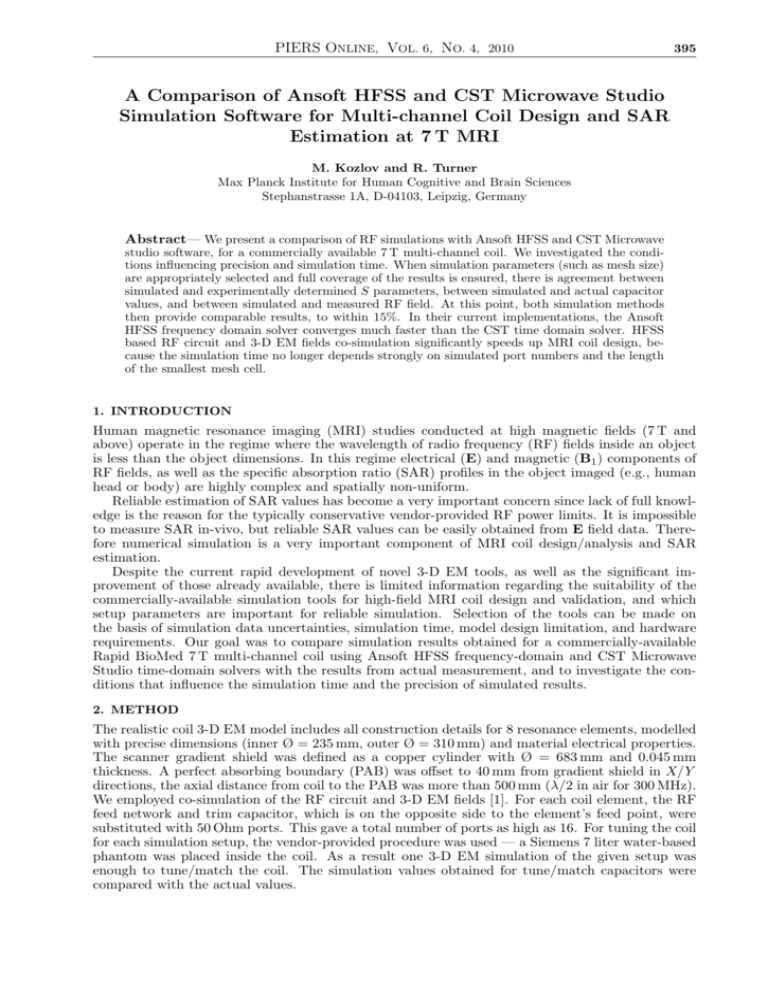
PIERS ONLINE, VOL. 6, NO. 4, 2010 395 A Comparison of Ansoft HFSS and CST Microwave Studio Simulation Software for Multi-channel Coil Design and SAR Estimation at 7 T MRI M. Kozlov and R. Turner Max Planck Institute for Human Cognitive and Brain Sciences Stephanstrasse 1A, D-04103, Leipzig, Germany Abstract— We present a comparison of RF simulations with Ansoft HFSS and CST Microwave studio software, for a commercially available 7 T multi-channel coil. We investigated the conditions influencing precision and simulation time. When simulation parameters (such as mesh size) are appropriately selected and full coverage of the results is ensured, there is agreement between simulated and experimentally determined S parameters, between simulated and actual capacitor values, and between simulated and measured RF field. At this point, both simulation methods then provide comparable results, to within 15%. In their current implementations, the Ansoft HFSS frequency domain solver converges much faster than the CST time domain solver. HFSS based RF circuit and 3-D EM fields co-simulation significantly speeds up MRI coil design, because the simulation time no longer depends strongly on simulated port numbers and the length of the smallest mesh cell. 1. INTRODUCTION Human magnetic resonance imaging (MRI) studies conducted at high magnetic fields (7 T and above) operate in the regime where the wavelength of radio frequency (RF) fields inside an object is less than the object dimensions. In this regime electrical (E) and magnetic (B1 ) components of RF fields, as well as the specific absorption ratio (SAR) profiles in the object imaged (e.g., human head or body) are highly complex and spatially non-uniform. Reliable estimation of SAR values has become a very important concern since lack of full knowledge is the reason for the typically conservative vendor-provided RF power limits. It is impossible to measure SAR in-vivo, but reliable SAR values can be easily obtained from E field data. Therefore numerical simulation is a very important component of MRI coil design/analysis and SAR estimation. Despite the current rapid development of novel 3-D EM tools, as well as the significant improvement of those already available, there is limited information regarding the suitability of the commercially-available simulation tools for high-field MRI coil design and validation, and which setup parameters are important for reliable simulation. Selection of the tools can be made on the basis of simulation data uncertainties, simulation time, model design limitation, and hardware requirements. Our goal was to compare simulation results obtained for a commercially-available Rapid BioMed 7 T multi-channel coil using Ansoft HFSS frequency-domain and CST Microwave Studio time-domain solvers with the results from actual measurement, and to investigate the conditions that influence the simulation time and the precision of simulated results. 2. METHOD The realistic coil 3-D EM model includes all construction details for 8 resonance elements, modelled with precise dimensions (inner Ø = 235 mm, outer Ø = 310 mm) and material electrical properties. The scanner gradient shield was defined as a copper cylinder with Ø = 683 mm and 0.045 mm thickness. A perfect absorbing boundary (PAB) was offset to 40 mm from gradient shield in X/Y directions, the axial distance from coil to the PAB was more than 500 mm (λ/2 in air for 300 MHz). We employed co-simulation of the RF circuit and 3-D EM fields [1]. For each coil element, the RF feed network and trim capacitor, which is on the opposite side to the element’s feed point, were substituted with 50 Ohm ports. This gave a total number of ports as high as 16. For tuning the coil for each simulation setup, the vendor-provided procedure was used — a Siemens 7 liter water-based phantom was placed inside the coil. As a result one 3-D EM simulation of the given setup was enough to tune/match the coil. The simulation values obtained for tune/match capacitors were compared with the actual values. PIERS ONLINE, VOL. 6, NO. 4, 2010 Figure 1: Simulation setup. 396 Figure 2: Lumped element mesh. Left: wrong mesh, right: correct mesh. Because this coil cannot be re-tuned once installed in the MRI scanner, we kept variable capacitor values and mesh definition fixed for each simulation setup when conducting an investigation of SAR. In this case, changing the simulation object from the phantom to a head model corresponds to experimental substitution of the phantom by an in-vivo subject inside the tuned and matched MRI coil. SAR was evaluated using an in-vivo load consisting of the head and part of the shoulders of the Ansoft surface-based human body model (Fig. 1), with different spatial scaling factors. Since the SAR calculation procedure incorporated within CST is very slow (up to 10 hours for 50 million mesh cells) and HFSS does not include IEC-recommended SAR evaluation, we generally used a home-built fast and reliable SAR calculation procedure, versatile with regard to both 3-D EM solver strategies, and adapted to multi-core processing [2]. We found negligible difference in the SAR data evaluated by CST procedure and this in-house method. 3. RESULTS AND DISCUSSION HFSS offers a reliable mesh adaptation algorithm and several simulation coverage criteria, sufficient to obtain reliable data in one simulation run. Correct trim capacitor estimation was obtained in an HFSS simulation, in which initial manual mesh seeding was provided to get at least 3 tetrahedra within each current-conducting element cross section. The S-parameter coverage criteria were defined to be better than 0.0025. The project mesh reached ∼2.4 million tetrahedra after 5 mesh adaptation steps. CST also includes several coverage criteria but its suitable for multi-channel MRI coil simulation mesh adaptation procedure is based on increasing the “Lines per wavelength” and “Lower mesh limit” settings. This refinement over the entire model volume is a less robust approach, compared with HFSS mesh refinement, which is performed mostly in the volumes containing maximum field values. For complex MRI coil simulations, CST coverage criteria are used rather seldom, due to the extremely long computational times. In addition, mesh refinement for a given wavelength makes it impossible to keep the same mesh of coil elements for phantom and human model simulations. As it will be shown below the latter is important for reliable SAR prediction. For CST simulations, mesh definition has a significant influence on representation of areas that include ports and lumped elements. In the simulated coil, ports and lumped elements are not aligned parallel to a coordinate axis. In these areas the mesh step was decreased until the relevant mesh vertexes were accurately positioned as start and end points for integration across ports or lumped elements (Fig. 2). If too coarse a mesh is used, integration defining a significant dependence of port impedance and lumped element properties may erroneously include conductor material. This may result in overestimation or underestimation of SAR by up to 30%. Keeping correct port and lumped element mesh definition (mesh step size as small as 0.25 mm) the coil element mesh size was manually decreased, step by step, until the difference between experimental and simulated trim capacitor values vanished (Table 1). Because the current distribution is maximal on the conductor edges, a relatively small hexahedral mesh step must be used for the reliable representation of radiative coil elements when these are not aligned parallel to a coordinate axis. This result underlines the importance of keeping the same coil element mesh definition between phantom and human model simulations. For CST simulation, increasing the number of mesh cells resulted in nearly the same shape of B1 + profile within a phantom (Fig. 3), but approximately a 75% variation of peak SAR value PIERS ONLINE, VOL. 6, NO. 4, 2010 397 for some head models (Table 1). SAR was found to be coupled to two different E field sources (conservative and non-conservative). The first is the penetration of the E field from the distributed capacitors commonly used in high field MRI coils, the second is the E field that accompanies the propagating magnetic field. When the conservative E field has significant influence, care must be taken to ensure that the mesh definition is smaller than 1.25 mm, whenever a part of the human body model is close to a capacitor (Fig. 4). For the mainly non-conservative E field within the body, changes of the SAR value for the coil investigated are less than +/ − 10%, once the mesh cell size is less than 2 mm isotropic for coil elements. There is less than 15% difference between field and SAR (point to point data comparison) for HFSS and CST simulations, once simulation setup and parameters are correctly chosen. For CST this means that the steady state monitor must be set below −60 dB, in addition to the precautions Table 1: CST and HFSS simulation data. Coil element mesh, isotropic [mm] Tune capacitor value [pF] SAR for Head model SAR for Head 0.8 scaled model 2.25 29.8 2.00 1.73 2 24.9 1.87 1.64 CST 1.5 1.25 17.1 16.1 1.43 1.38 1.68 1.71 1 12.8 1.30 1.74 0.8 11.3 1.28 1.70 HFSS variable 11.2 1.21 1.76 Figure 3: Transversal B1 + maps for Siemens phantom. Left: CST coil mesh 2.25 mm, center: CST coil mesh 1 mm, right: HFSS. Figure 4: Head with scaling 1. Left: CST SAR for coil mesh 2.25 mm, center: CST SAR for coil mesh 0.8 mm, right: HFSS SAR data. PIERS ONLINE, VOL. 6, NO. 4, 2010 398 discussed above that ensure full coverage and agreement between simulated and actual capacitor values. This monitor guides CST solver accuracy during time domain simulation by comparing the total energy at each time point within the volume of interest relative to the peak value of this total energy. The simulation terminates when the defined level is reached. The lower this level, the more accurate are both the S parameters and the field simulation data obtained by the Fourier transformation of the time domain values. The simulations of the coil investigated required several months and about 16 GB RAM memory for CST, and two days and 62 GB RAM memory for HFSS projects running on the same computer, without simulation parallelization and hardware acceleration. The memory size disadvantage for HFSS is not severely problematic today, with commercially available 64 GB memory workstations. The computational time disadvantage for CST is a consequence of the inverse proportionality of the simulation time to the length of the smallest mesh cell, which has to be quite small for reliable simulation of a complex MRI coil. In addition, if the computation is performed in CST, each port is simulated independently. This means that the simulation time for the entire project is linearly proportional to the number of ports, and simulation of 8-channel coil with 16 ports, could take several weeks, despite use of several computers for port simulation parallelization. Usage of the RF circuit and 3-D EM co-simulation approach is not a reason for the extremely long CST simulation time (Table 2). In opposite, if the approach is used simulation time is the shortest for coils, which effective coil-loss resistance (RΣ ) is less than 6.25 Ohm. RΣ is calculated from the power absorbed by coil and the sum of each element’s feed current. RΣ = 0.52 Ohm for the coil investigated. Figure 5: Head with scaling 0.8. Left: CST SAR for coil mesh 1 mm, right: HFSS SAR data. Table 2: Comparison of CST FDTD simulation time for an 8 channel coil with given coil quality factor Q. Number of excitations Simulation time of single excitation in proportion to Total simulation time in proportion to Simultaneous port excitation of tuned/matched coil 1 Individual ports excitation of tuned/matched coil 8 Q Q Q 8×Q RF circuit 3-D EM co-simulation 16 RΣ Q× 2 × Rport Q× 16 × RΣ 2 × Rport PIERS ONLINE, VOL. 6, NO. 4, 2010 399 4. CONCLUSION When simulation parameters (such as mesh size and coverage criteria) are appropriately selected, there is agreement between simulated and experimentally determined S parameters, and also between simulated and actual capacitor values. At this point, RF field simulations and measurements also agree and both simulation methods then provide comparable results. In their current implementations, the Ansoft HFSS frequency domain solver converges much faster than the CST time domain solver. HFSS based RF circuit and 3-D EM fields co-simulation significantly speeds up MRI coil design, because the simulation time no longer depends strongly on simulated port numbers and the length of the smallest mesh cell. To obtain reliable CST data, the CST solver accuracy requires a steady state monitor setting that is better than −60 dB, and the mesh size must be manually decreased step-by-step to ensure full coverage of the results. Furthermore, simulation must be performed using a realistic head model, together with the same mesh definition and tune/match network as used for simulation with a phantom corresponding to the standard product tuning procedure. For the reliable simulation of distributed capacitance, the CST mesh has to be smaller than the thinnest dielectric elements of the coil. This is more important for coil tuning (e.g., trim capacitor) estimation than for SAR. REFERENCES 1. Kozlov, M. and R. Turner, “Fast MRI coil analysis based on 3-D electromagnetic and RF circuit co-simulation,” Journal of Magnetic Resonance, Vol. 200 147–152, 2009. 2. Kozlov, M. and R. Turner, “Optimization of SAR calculation for 3-D EM time and frequency domain data,” Proceedings of International Society for Magnetic Resonance in Medicine, 4779, Honolulu, USA, April 2009.
